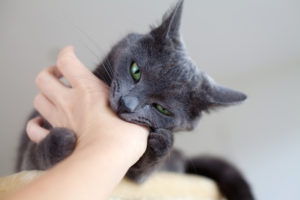If your favorite feline seems to be abandoning his litterbox in favor of greener pastures (or the living room rug!), it’s important to realize that there is almost always a reason why your cat is pooping outside the litter box.
Veterinarians know that some medical issues can cause kitties to poop outside of their litter box, but that cat behavior and hygiene issues are far more common. If your cat is losing weight, vomiting, having diarrhea, or straining to pass a bowel movement, it’s best to start with a vet visit to look for any medical issues that may be altering your cat’s habits.
If your cat isn’t showing any of these symptoms, there’s good news: as a cat owner, you can do a lot of troubleshooting at home to determine if your cat just needs a bathroom makeover!
Keep reading to find out what you can do at home to keep your cat from thinking outside of the box.
Litter Box Hygiene
Would you rather use the bathroom in a five-star hotel, or use a Port-a-Potty? That may be the type of choice you are offering your beloved kitty—at least in his eyes!
Cats are VERY particular about cleanliness, as you know. They spend hours a day grooming themselves to keep their bodies clean, and expect the same standards in their bathroom facilities. Walking into a litter box with urine clumps and excrement can be very off-putting to your kitty. If this happens, it’s no wonder that they may choose to relieve themselves under more “pristine” conditions—even if that is next to the box, or in your living room.
Keep in mind that litter box fresheners and scented litter may be offensive smells to your cat, so it’s best to implement odor control outside of the box and use unscented litter in it. What smells good to human noses from a distance can be “ewww”inducing to cats when they are up close and personal with the scent, and can actually serve to deter them from stepping foot inside!
Just like with people, proper hygiene in the bathroom area is essential. Veterinarians hear from cat owners who scoop the litter boxes twice a week—or even less frequently! The buildup of odor, urine, and feces is a HUGE deterrent to most cats when it comes to using their dedicated bathroom. In fact, it’s ideal to scoop the cat poop from the litter tray twice a day, and make sure that your kitties always have access to a clean box by having one more litterbox than there are cats in the household. Yes, for a two-kitty family, that means THREE litter boxes!
If these logistics are a struggle for your multiple cats and/or home situation, consider investing in an automatic self-cleaning litter box for your furry friend so that they always have a clean option with fresh litter available.
Location, Location, Location!
Is your dining room right next to your toilet? No? Well, your cat wouldn’t be cool with that, either! Just like us, cats like to eat in a different area than they use the bathroom. Make sure that your cat’s litter boxes are in locations far away from their food and water bowls to encourage regular use. Sometimes this simple adjustment is all that’s needed to keep your kitty in the box!
Cats also like peace and quiet during their private time in the bathroom, so be sure to place your litter boxes in areas away from noisy home appliances. While the laundry room might seem like the most convenient place for your cats to do their business, noisy rattling washing machines and dryers might make them too agitated to use the box as they should. Peace, quiet, and privacy are the guidelines for the perfect litter box location.
Shape and Size
If your cat is house soiling, it may be because they don’t have enough room in the box to properly position themselves and to bury their waste. Natural feline instincts dictate an average of twenty seconds of scooping litter over their urine or feces to hide their scent. If the box is too small, they can’t fulfill this natural part of the elimination process. Any time your cat’s natural instincts are thwarted, it is a recipe for stress—and for looking at other places to do their business.
As a general rule of thumb, a litter box’s length should be 1.5x the length of the cat’s body (not including their tail). Take your eagle eye to your cat’s box and see if it seems large enough for your kitty. It can be difficult to find a large enough litter box, especially for larger cats, so feel free to repurpose a plastic storage bin into a spacious kitty bathroom.
Some cats prefer to have covered litter boxes, but most cats prefer a more “open air” design. If your current boxes are covered, an easy solution might be to simply remove the cover from the boxes and see if your cat is using them more regularly.
If you have a senior cat and the sides of your litter boxes are high, your kitty may be experiencing some difficulty getting in and out of the box to do their business. Arthritis is underdiagnosed in cats and is exceedingly common in older cats. If your cat seems to prefer more shallow-entry boxes, make sure to take him to your veterinarian to see if he needs some help with arthritis pain.
The Cafeteria Approach to Cat Litter…and Beyond!
Finally, some cats just don’t like the texture of certain types of cat litter. In general, cats like finer, granulated materials beneath their cute little paws while they posture to poop and pee. Some cat litter particles are sharp and uncomfortable on those delicate paw pads.
What’s a loving cat parent to do? The “cafeteria approach” can help you select your cat’s favorite litter! Set up a row of three (or more) temporary litter boxes with different litter next to each other in an ideal location. Use a different texture of litter for each box—examples include clumping litter, pine pellets, crystal litter, and waxy pellets. Next, see which box proves to be the most popular place for your kitty to use the bathroom. You might be surprised that your cat’s preference is different from what you have been using!
You can also use the “cafeteria approach” to test out covered versus uncovered litter boxes, or different shapes/sizes and shallow-entry boxes.
The Bottom Line
If your cat has started pooping outside of the box, it’s time to re-evaluate their bathroom environment and potential litter box problem. If your cat is losing weight, vomiting, has a change in their appetite, is having diarrhea, or straining to pass bowel movements, then a vet visit should be your first stop! If your kitty is otherwise acting like his normal self and his poops are normal in size and texture, use the tips above to see if you can break the habit of “thinking outside the box.” If your kitty is demonstrating other behavioral issues, we can also help answer questions about how to calm down a cat, signs of stress in cats, as well as “why does my cat randomly bite me.”
As always, our AskVet Veterinarians are available to discuss all of your pet’s needs 24 hours a day, 7 days a week. Whether you have an immediate need or are looking to improve your pet’s overall wellbeing – our Certified Pet Lifestyle Experts can create a custom plan, just sign into your account and one of our friendly and knowledgeable veterinary experts or CPLE will attend to your needs, no appointment required! Sign up today!
Written by:
Allison Ward, DVM
Dr. Allison Ward grew up in the suburbs of Washington, D.C. and started working in veterinary hospitals when she was 14 years old. After graduating from veterinary school in 2011, she completed a small animal rotating internship in New Jersey, followed by a neurology/neurosurgery internship in Miami. After completing this advanced training, Dr. Ward then moved on to general small animal practice. Dr. Ward’s professional interests include feline medicine, neurology, and pain management. Her passion for educating pet owners carries over into her work with AskVet, and she loves being able to help pets and their parents at all times of the day (and night!). She currently resides in sunny south Florida with her two cats, Larry and George.








